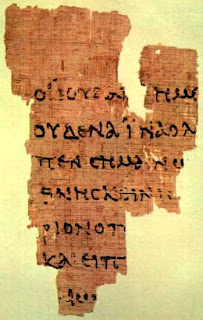Almost invariably these days sceptics come up with the argument that the New Testament (NT) documents are unreliable because they were written long after the events they purport to describe took place.
In my experience this claim is almost never backed up with any evidence other than hearsay.
So on what do I base my confidence that the NT documents were written in the lifespan of the eyewitnesses to Jesus’ death and resurrection?
Let me summarise the arguments (although there is more detail here and a good summary herefrom which much of the following is gleaned)
The NT contains 27 separate books which have been gathered together in one volume. There are four Gospel accounts of the life of Jesus (Matthew, Mark, Luke and John), the book of Acts (which describes the history of the early church), thirteen letters by Paul , three by John, two by Peter, one by each of Jude and James, the letter to the Hebrews (disputed authorship) and the book of Revelation.
The best way of dating these books is to begin with the book of Acts as it makes reference to two key historical events, the dates of which are established by archeological evidence independent of it.
The first of these is Claudius’ edict expelling the Jews from Rome in AD 50, which sent Aquila and Priscilla to Corinth (Acts 18:2).
The second is an inscription at Delphi, in central Greece, that contains a proclamation of the Emperor Claudius referring to Gallio as the Roman Proconsul of Greece dated to AD 52 (Acts 18:12).
These two events correspond in Acts to Paul’s arrival in Corinth and his ensuing trial.
So Acts was written after AD 52 and most scholars date it to AD 62 on the following basis as argued by Roman historian Colin Hemer:
1. There is no mention in Acts of the crucial event of the fall of Jerusalem in 70.
2. There is no hint of the outbreak of the Jewish War in 66 or of serious deterioration of relations between Romans and Jews before that time.
3. There is no hint of the deterioration of Christian relations with Rome during the Neronian persecution of the late 60s.
4. There is no hint of the death of James at the hands of the Sanhedrin in ca. 62, which is recorded by Josephus in Antiquities of the Jews (20.9.1.200).
5. Acts seems to antedate the arrival of Peter in Rome and implies that Peter (who was martyred in the late 60s) and John were alive at the time of the writing.
6. The action ends very early in the 60s, yet the description in Acts 27 and 28 is written with a vivid immediacy. It is also an odd place to end the book if years have passed since the pre-62 events transpired.
2. There is no hint of the outbreak of the Jewish War in 66 or of serious deterioration of relations between Romans and Jews before that time.
3. There is no hint of the deterioration of Christian relations with Rome during the Neronian persecution of the late 60s.
4. There is no hint of the death of James at the hands of the Sanhedrin in ca. 62, which is recorded by Josephus in Antiquities of the Jews (20.9.1.200).
5. Acts seems to antedate the arrival of Peter in Rome and implies that Peter (who was martyred in the late 60s) and John were alive at the time of the writing.
6. The action ends very early in the 60s, yet the description in Acts 27 and 28 is written with a vivid immediacy. It is also an odd place to end the book if years have passed since the pre-62 events transpired.
The Gospel of Luke was written by the same author as the Acts of the Apostles, who refers to Luke as the 'former account' of 'all that Jesus began to do and teach' (Acts 1:1). The destiny ('Theophilus'), style, and vocabulary of the two books betray a common author.
The author of Luke and Acts was a companion of Paul on his journeys (the 'we' passages in Acts) and is attested by 2nd century church fathers, many of whom would have been alive at the time Luke and Acts were written, to be Luke the Physician.
The author of Luke and Acts was a companion of Paul on his journeys (the 'we' passages in Acts) and is attested by 2nd century church fathers, many of whom would have been alive at the time Luke and Acts were written, to be Luke the Physician.
If Acts was written in 62 or before, and Luke was written before Acts (say 60), then Luke was written less than thirty years of the death of Jesus. This is contemporary to the generation who witnessed the events of Jesus' life, death, and resurrection. This is precisely what Luke claims in the prologue to his Gospel:
Many have undertaken to draw up a record of the things that have been fulfilled among us, just as they were handed down to us by those who were eye-witnesses and servants of the word. Therefore, since I myself have carefully investigated everything from the beginning, it seemed good also to me to write an orderly account for you, most excellent Theophilus, so that you may know the certainty of the things you have been taught. [Luke 1:1-4]
Luke presents the same information about who Jesus is, what he taught, and his death and resurrection as do the other Gospels. Thus, there is not a reason to reject their historical accuracy either. Most scholars would hold to the view, on the basis of shared material, that Mark was written first, followed by Matthew, then Luke which puts the earlier gospels back into the 50s at the latest.
It is widely accepted by critical and conservative scholars that 1 Corinthians was written by 55 or 56. This is less than a quarter century after the crucifixion in 33.
Further, Paul speaks of more than 500 eyewitnesses to the resurrection who were still alive when he wrote (15:6). Specifically mentioned are the twelve apostles and James the brother of Jesus. Internal evidence is strong for this early date:
1. The book repeatedly claims to be written by Paul (1:1, 12-17; 3:4, 6, 22; 16:21).
2. There are parallels with the book of Acts.
3. Paul mentions 500 who had seen Christ, most of whom were still alive.
4. The contents harmonize with what has been learned about Corinth during that era.
2. There are parallels with the book of Acts.
3. Paul mentions 500 who had seen Christ, most of whom were still alive.
4. The contents harmonize with what has been learned about Corinth during that era.
There is also external evidence:
1. Clement of Rome refers to it in his own Epistle to the Corinthians (chap. 47.)
2. The Epistle of Barnabas alludes to it (chap. 4).
3. Shepherd of Hermas mentions it (chap. 4).
4. There are nearly 600 quotations of 1 Corinthians in Irenaeus, Clement of Alexandria, and Tertullian alone (Theissen, 201). It is one of the best attested books of any kind from the ancient world.
2. The Epistle of Barnabas alludes to it (chap. 4).
3. Shepherd of Hermas mentions it (chap. 4).
4. There are nearly 600 quotations of 1 Corinthians in Irenaeus, Clement of Alexandria, and Tertullian alone (Theissen, 201). It is one of the best attested books of any kind from the ancient world.
Along with 1 Corinthians, 2 Corinthians and Galatians are well attested and early. All three reveal a historical interest in the events of Jesus' life and give facts that agree with the Gospels. Paul speaks of Jesus' virgin birth (Gal. 4:4), sinless life (2 Cor. 5:21), death on the cross (1 Cor. 15:3; Gal. 3:13); resurrection on the third day (1 Cor. 15:4), and post-resurrection appearances (1 Cor. 15:5-8). He mentions the hundreds of eyewitnesses who could verify the resurrection (1 Cor. 15:6).
Paul rests the truth of Christianity on the historicity of the resurrection (1 Cor. 15:12-19). Paul also gives historical details about Jesus' contemporaries, the apostles (1 Cor. 15:5-8), including his private encounters with Peter and the apostles (Gal. 1:18-2:14).
Paul's other books can be dated around events described in the book of Acts. He wrote Romans during his three month stay in Greece in AD 57. Ephesians, Philippians, Colossians and Philemon were written whilst he was in prison in Rome between AD 60-62. 1 Timothy was written after Paul's release from prison in AD 62 and 2 Timothy just before his martyrdom in AD 64.
Paul's other books can be dated around events described in the book of Acts. He wrote Romans during his three month stay in Greece in AD 57. Ephesians, Philippians, Colossians and Philemon were written whilst he was in prison in Rome between AD 60-62. 1 Timothy was written after Paul's release from prison in AD 62 and 2 Timothy just before his martyrdom in AD 64.
Surrounding persons, places, and events of Christ's birth were all historical. Luke goes to great pains to note that Jesus was born during the days of Caesar Augustus (Luke 2:1) and was baptised in the fifteenth year of Tiberius. Pontius Pilate was governor of Judea and Herod was tetrarch of Galilee. Annas and Caiaphas were high priests (Luke 3:1-2).
Of the four Gospels alone there are 19,368 citations by the church fathers from the late first century on. This includes 268 by Justin Martyr (100-165), 1038 by Irenaeus(active in the late second century), 1017 by Clement of Alexandria (ca. 155-ca. 220), 9231 by Origen (ca. 185-ca. 254), 3822 by Tertullian (ca. 160s-ca. 220), (ca. 160s-ca. 220), 734 by Hippolytus (d. ca. 236), and 3258 by Eusebius (ca. 265-ca.339; Geisler, 431).
Earlier, Clement of Rome cited Matthew, John, and 1 Corinthians, in 95 to 97. Ignatius referred to six Pauline epistles in about 110, and between 110 and 150 Polycarp quoted from all four gospels, Acts, and most of Paul's epistles.
Shepherd of Hermas (115-140) cited Matthew, Mark, Acts, 1 Corinthians, and other books. Didache (120-150) referred to Matthew, Luke, 1 Corinthians, and other books. Papias, companion of Polycarp, who was a disciple of the apostle John, quoted John. This argues powerfully that the gospels were in existence before the end of the first century, while some eyewitnesses (including John) were still alive.
The earliest undisputed manuscript of a New Testament book is the John Rylands papyrus (p52) (pictured above), dated from 117 to 138. This fragment of John's gospel survives from within a generation of composition. Since the book was composed in Asia Minor and this fragment was found in Egypt, some circulation time is demanded, surely placing composition of John within the first century. Whole books (Bodmer Papyri) are available from 200.
Most of the New Testament, including all the gospels, is available in the Chester Beatty Papyri manuscript from 150 years after the New Testament was finished (ca. 250). No other book from the ancient world has as small a time gap between composition and earliest manuscript copies as the New Testament.
See also ‘Is the Bible reliable?’
You have read this article Apologetics
with the title February 2013. You can bookmark this page URL http://celebrityunitedking.blogspot.com/2013/02/how-do-we-know-nt-documents-were.html. Thanks!

















